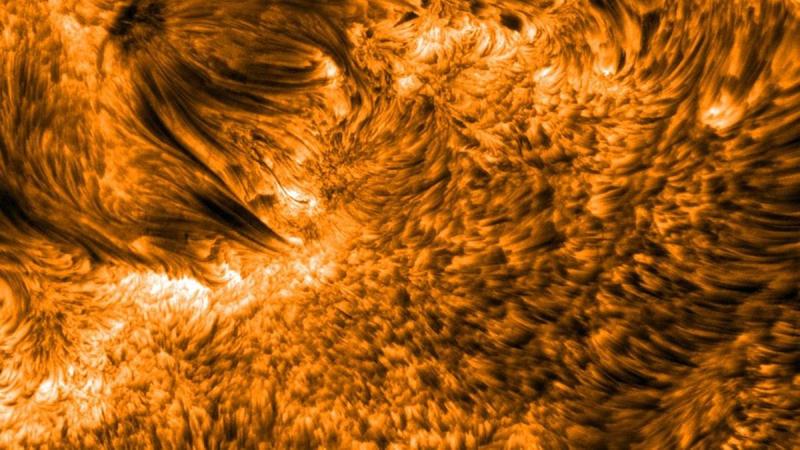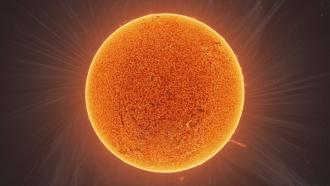
At first glance, the study of the Sun may appear commonplace and unremarkable when compared to the study of distant galaxies and enchanting supernovae. However, since the Sun is the closest star to us, it provides us with an opportunity to study chemical, physical and nuclear processes in a typical star. Besides, the Sun also provides us with a natural laboratory for studying the physics of plasmas—scorching matter consisting of charged particles whose electrons have been stripped off. Hence, scientists around the world are studying the various activities going on in the solar atmosphere.
One such exciting activity is solar spicules. Akin to how volcanoes on the Earth’s surface spit out hot lava, the Sun too spits out jets of plasma at high speeds. Known as spicules, they typically are expelled at speeds between 50,000 km/hr and 150,000 km/hr—about twice the velocity of a rocket jetting into space! Each spicule lasts for a few minutes, reaching a height of several thousand kilometres before falling back and fading away. Unlike volcanoes, these spicules are so common that at any given time, about 1% of the Sun’s surface is covered by them.
So far, scientists have found it difficult to understand how these spicules originate, and the role they play in heating the solar atmosphere. To help shed light on these issues, an international team of scientists from China, the USA, the UK, Hungary, Austria, Germany and India, have carried out observations of the Sun using the Goode Solar Telescope (GST) at the Big Bear Solar Observatory in the USA. Their study is published in the journal Science.
“High-resolution observations of the magnetic field and corresponding observations of other atmospheric layers is the key for the understanding of the dynamics in the solar atmosphere,” says Prof Dipankar Banerjee, explaining the approach taken by the researchers in this study.
He is an astrophysicist at the Indian Institute of Astrophysics, Bengaluru, and an author of the current study.
The researchers observed the Sun at visible wavelengths using filters that only let in light within a narrow range of wavelengths. Simultaneously, they used the GST’s Near Infra-Red Imaging Spectropolarimeter (NIRIS) to measure the polarisation of light. Light consists of oscillating electric and magnetic fields. In the presence of external magnetic fields, these can be aligned in specific directions, producing what is known as polarised light. Measuring the pattern of polarisation at different wavelengths enables the researchers to infer the strength and structure of the magnetic field.
By combining the two observations, the researchers discovered that solar spicules are generated by the interaction of magnetic fields with opposite polarity, through a phenomenon known as magnetic reconnection.
The Sun’s atmosphere is hot enough to strip electrons from hydrogen atoms leaving us with fast-moving charged particles. These charged particles, owing to their motion, generate magnetic fields. As the solar atmosphere is highly dynamic, these particles swirl around and the magnetic fields get twisted and tangled. This activity can create an explosive process known as “magnetic reconnection” when substantial amounts of energy in the magnetic field are converted to the kinetic energy of the particles, driving these volcano-like spicules.
In the past, scientists speculated that these spicules were a result of shock waves, upward forces associated with magnetized plasma, magnetic forces amplified when neutral and charged particles interact or due to the reconnection between oppositely-directed magnetic fields.
“Our observations strongly support the hypothesis that the process of magnetic reconnection drives many spicules”, says Dr Hui Tian is an astrophysicist from the School of Earth and Space Sciences, Peking University, China, and the corresponding author of the current study.
However, the researchers are not sure whether this mechanism produces all spicules.
“But, at least, we can tell that most of the spicules observed by us are most likely produced by magnetic reconnection,” says Dr Tian.
The researchers believe that their observations may also hold the key to another long-standing problem in the field—the unusually hot solar corona. The Sun’s corona, the outermost part of the Sun’s atmosphere that is only visible to the naked eye during solar eclipses, is much hotter than the Sun’s surface, and scientists are yet to understand why completely. Since these spicules supply hot plasma to the solar corona, it could be heating it, say the researchers.
“Our observations reveal a highly dynamic solar atmosphere. Our results demonstrate that solar spicules play a key role in the process of coronal heating, and that coronal heating is closely related to magnetic activities in the lower solar atmosphere,” explains Dr Tian.
With the Daniel K. Inouye Solar Telescope (DKIST)—the world’s largest solar telescope situated in Hawaii, USA—scheduled to be operational next year, the researchers hope to find more answers.
“We plan to make even higher resolution observation with facilities like the DKIST,” signs off Dr Banerjee.
This article has been run past the researchers, whose work is covered, to ensure accuracy.






